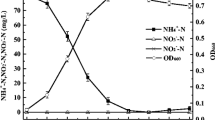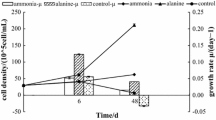Abstract
The effect of various organic compounds on the growth of ammonia-oxidizing bacteria was examined.Nitrosococcus oceanus, a strongly halophilic bacterium, had a very low tolerance to organic matter compared with other organisms tested. Organic compounds scarcely affected the growth of theNitrosomonas strains whereas nitrite formation by bothNitrosococcus mobilis strains was inhibited by nearly all of the substances tested. The growth ofNitrosospira strain Nsp1 was enhanced more than 30% by acetate and formate, but not growth was detectable in the presence of pyruvate. On the contrary,Nitrosospira strain Nsp5 was stimulated only by pyruvate. Nitrite formation by the twoNitrosovibrio tenuis strains tested was similar. The growth of both strains was enhanced considerably by formate and glucose; acetate and, to a greater extent, pyruvate inhibited these bacteria.
In batch culture, the energy efficiency of autotrophically grown ammonia-oxidizing bacteria varied from strain to strain. The cell yield of mixotrophically grown cultures, per unit of ammonia oxidized, was increased in comparison with autotrophic ones. No heterotrophic growth was detected.
Similar content being viewed by others
References
Borichewski RM, Umbreit WW (1966) The growth ofThiobacillus thiooxidans on glucose. Arch Biochem Biophys 116:97–102
Clark C, Schmidt EL (1966) Effect of mixed culture ofNitrosomonas europaea stimulated by uptake and utilization of pyruvate. J Bacteriol 91:367–373
Clark C, Schmidt EL (1967a) Growth response ofNitrosomonas europaea to amino acids. J Bacteriol 93:1302–1307
Clark C, Schmidt EL (1967b) Uptake and utilization of amino acids by resting cells ofNitrosomonas europaea. J Bacteriol 93:1309–1315
Engel H (1960) Die Nitrifikanten. In: Ruhland W (ed) Handbuch Pflanzemphysiol, vol V/2. Springer, Berlin Göttingen Heidelberg, pp 664–681
Gundersen K (1955) Effects of B-vitamins and amino-acids on nitrification. Physiol Plant 8:136–141
Harms H, Koops H-P, Wehrmann H (1976) An ammonia-oxidizing bacterium,Nitrosovibrio tenuis nov. gen. nov. sp. Arch Microbiol 108:105–111
Heubült I (1929) Untersuchungen über Nitribakterien. Planta 8:398–422
Hofman T, Lees H (1952) The biochemistry of nitrifying organisms. 2. The free-energy efficiency ofNitrosomonas. Biochem J 52:140–142
Hooper AB (1969) Biochemical basis of the obligate autotrophy inNitrosomonas europaea. J Bacteriol 97:776–779
Kelly DP (1971) Autotrophy: concepts of lithotrophic bacteria and their organic metabolism. Ann Rev Microbiol 25:177–210
Kingma Boltijes TY (1935) Untersuchungen über die nitrifizierenden Bakterien. Arch Mikrobiol 6:79–138
Koops, H-P (1969) Der Nutzeffekt der NH +4 -Oxidation durchNitrosocystis oceanus Watson. Arch Mikrobiol 65:115–135
Koops H-P, Harms H, Wehrmann H (1976) Isolation of a moderate halophilic ammonia-oxidizing bacterium,Nitrosococcus mobilis nov. sp. Arch Microbiol 107:277–282
Krümmel A, Harms H (1980) Der Einfluß anorganischer Ionen auf das Wachstum von zweiNitrosomonas-Stämmen aus verschiedenen Biotopen. Mitt Inst Allg Bot Hamburg 17:89–100
Kuenen JG, Veldkamp H (1973) Effects of organic compounds on growth of chemostat cultures ofThiomicrospira pelophila, Thiobacilus thioparus andThiobacillus neapolitanus. Arch Mikrobiol 94:173–190
Laudelout H, Simonart PC, van Droogenbroeck R (1968) Calorimetric measurement of free energy utilization byNitrosomonas andNitrobacter. Arch Mikrobiol 63:256–277
London J, Rittenberg SC (1966) Effects of organic matter on the growth ofThiobacillus intermedius. J Bacteriol 91:1062–1069
Lu MC, Matin A, Rittenberg SC (1971) Inhibition of growth of obligately chemolithotrophic thiobacilli by amino acids. Arch Mikrobiol 79:354–366
Martiny H (1979) Vergleichende Untersuchungen über die Aufnahme und den Einbau organischer C-Verbindungen durch chemolithoautotrophe ammoniakoxidierende Bakterien. Diss Univ Hamburg
Matin A (1978) Organic nutrition of chemolithotrophic bacteria. Ann Rev Microbiol 32:433–468
Pan P, Umbreit WW (1972) Growth of obligate autotrophic bacteria on glucose in a continuous flow-through apparatus. J Bacteriol 109:1149–1155
Rittenberg SC (1969) The role of exogenous organic matter in the physiology of chemolithotrophic bacteria. Adv Microbial Physiol 3:159–196
Schön G (1965) Untersuchungen über den Nutzeffekt vonNitrobacter winogradskyi Buch. Arch Mikrobiol 50:111–132
Smith AJ, Hoare DS (1977) Specialist phototrophs, lithotrophs, and methylotrophs: a unity among a diversity of procaryotes. Bacteriol Rev 41:419–448
Suzuki I, Kwok S-C, Dular U (1976) Competitive inhibition of ammonia oxidation inNitrosomonas europaea by methane, carbon monoxide or methanol. FEBS Lett 72:117–120
Watson SW (1971) Relsolation ofNitrosospira briensis S. Winogradsky and H. Winogradsky 1933. Arch Mikrobiol 75:179–188
Watson SW, Graham LB, Remsen CG, Valois FW (1971) A lobular, ammonia-oxidizing bacterium,Nitrosolobus multiformis nov. gen. nov. sp. Arch Mikrobiol 76:183–203
Williams PJB, Watson SW (1968) Autotrophy inNitrosocystis oceanus. J Bacteriol 96:1640–1648
Wullenweber M (1975) Versuche zum Wachstum ammoniakoxidierender Bakterien in statischer Kultur. Diplomarbeit, Univ Hamburg
Author information
Authors and Affiliations
Rights and permissions
About this article
Cite this article
Krümmel, A., Harms, H. Effect of organic matter on growth and cell yield of ammonia-oxidizing bacteria. Arch. Microbiol. 133, 50–54 (1982). https://doi.org/10.1007/BF00943769
Received:
Accepted:
Issue Date:
DOI: https://doi.org/10.1007/BF00943769




